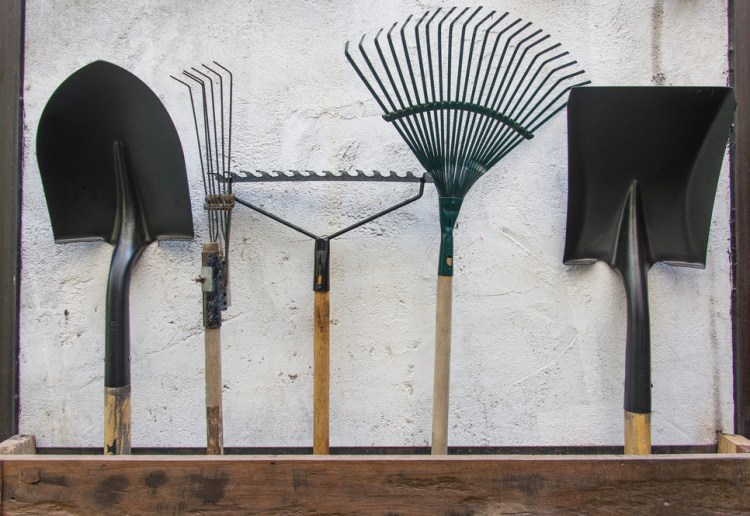A key facet of living a sustainable life is to throw away as few things as possible. This goes for furniture, clothing, vehicles, appliances and – the subject for this week – garden tools.
The practice of throwing away as few things as possible starts when you make the purchase – or, with many of the hoes, picks, spading forks, pry bars and garden rakes I use, when my wife Nancy’s grandparents made the purchase.
People aren’t saving money if they go to a national chain discount store and buy a tool made cheaply in China, and the tool breaks during the first season it is used. It will have to be replaced, which will cost more in the long run than if you’d bought a quality product.
The quality of the tool is not the only thing to research. The purchaser should also study the person who will be using the tools. Alert readers might have noticed that I did not include spades and shovels in the tools we inherited from Nancy’s ancestors. That is because your garden writer abuses spades and shovels, often using too much force trying to pry out rocks and roots rather than getting a pry bar or saw to do the job properly.
All of the wood-handled spades and shovels we inherited snapped many years ago. It was not the fault of the tools but the fault of the gardener. But after many decades, the gardener is unlikely to change his errant ways, so I adjusted what I purchased.
About a decade ago we bought spades and shovels with steel or polyester handles, which haven’t broken despite my abuse. It looks like they will outlast me.
On a similar subject, I have yet to find lawn rakes that will withstand the pressure I use to remove acorns and thatch from the soggy soil under the fall lawn. I will accept advice from readers on this subject, as I still break one lawn rake each fall.
Buying quality tools that will last for decades does create some work. These tools will need to be maintained. People who lead busier lives than I do will consider this a negative. I actually enjoy maintaining tools because I do it in late fall and winter, when I can’t be gardening.

Jody Arbo mows the lawn and fallen leaves at her home in Skowhegan earlier this month. Sharpening the blades of lawnmowers before putting them away for the winter will make them do a better job in the spring.
Tool maintenance gives me an excuse to head to the basement, play music by artists that Nancy does not enjoy as much as I do, and maybe even sing along in my grating monotone.
The first step is to clean the tools – which should be done before you take them to the cellar. A garden hose, a scrub brush and probably some detergent will get off most of the soil picked up during garden season, and doing the work outside keeps the soil out of your work space.
Your tools probably rusted a bit, and that rust should be removed. A small wire brush that fits into a drill works best for the worst of it, and coarse steel wool and/or medium-grit sandpaper will take care of the rest. Don’t sand the metal too hard. If the tool is going to last a century, regular sanding could thin the metal and weaken the tool over time.
It is important to sharpen all cutting tools. These include saws, pruners, loppers, mowers, trowels, spades and shovels.
For the lawn mower, I use a grinder that fits on the end of a drill. Our mower blade sharpener also fits on the end of a drill. For hand pruners, there is tool that includes a holder that grips onto the blade and lets you set the sharpener at the proper angle.
Saws take time, because each tooth needs to be sharpened separately, and you need to take care not to damage adjacent teeth. You also need a special file, which can be purchased online or possibly at your local hardware store.
For lawn edgers, shovels and spades I usually use a hand file, although I have my father-in-law’s power grinder. I’ve learned from experience that the power grinder is usually overkill.
Once everything is sharpened, rub your hand over the handles. If you find any jags or rough spots that you hadn’t previously noticed – because you wear gardening gloves – sand them smooth. I almost always wear gloves when gardening, but sometimes for a quick job I’ll skip them. Naturally, that’s when I get a splinter.
You want to oil everything – the metal and the wood, but not the polyester handles. You can use light motor oil, but I prefer boiled linseed oil, which I have on hand for furniture restoration and maintenance. (I was once asked how long you had to boil it. You don’t. The manufacturer boils it and puts it in a can.)
The oil prevents rust and preserves the wood.
Finally, hang up the tools. It keeps them cleaner and prevents rust that will form if the metal parts are on a concrete floor.
You are then free to ski, skate, snowshoe or escape to warmer climates while waiting for gardening weather to return.
ABOUT THE WRITER
TOM ATWELL is a freelance writer gardening in Cape Elizabeth. He can be contacted at: tomatwell@me.com.
Send questions/comments to the editors.


